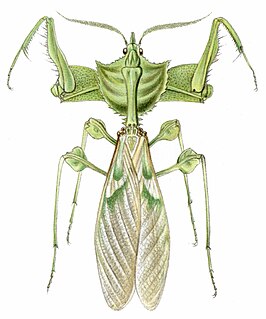 W
WEmpusidae is a family of plant-mimicking mantids, consisting of 10 genera, holding almost 30 species. Unlike many other mantid families, the Empusidae are a monophyletic lineage. Empusidae mantids are ambush predators, with mouthparts adapted to feeding on other insects and small animals. The majority of Empusidae species are distributed throughout Africa, but they are also found in Southeast Asia and in the southern parts of Europe.
 W
WBlepharopsis is a genus of praying mantis in the family Empusidae. This genus has only one species, Blepharopsis mendica.
 W
WEmpusa is a genus of mantises in the family Empusidae, containing the following species:
 W
WEmpusa fasciata is a species of praying mantis in the genus Empusa in the order Mantodea.
 W
WEmpusa pennata, or the conehead mantis, is a species of praying mantis in genus Empusa native to the Mediterranean Region. It can be found in Portugal, Spain, southern France, Italy and on the mediterranean coasts of Morocco, Algeria, Tunisia, Libya and Egypt. Because of its fragmented, low density populations, it is very rarely found in nature.
 W
WGongylus is a genus of empusids in the order Mantodea. Characterized by extremely slender limbs with large appendages, at least one species is kept as a pet by hobbyists. Males of the species are capable of flight.
 W
WGongylus gongylodes, also known as the wandering violin mantis, ornate mantis, or Indian rose mantis, is an insect of the order Mantodea. Characterized by extremely slender limbs with large appendages. It is not a particularly aggressive species and often kept as a pet by hobbyists. The mantis is especially known for swaying its body back and forth to imitate a stick flowing in the wind. It primarily feeds on flying insects. Its native range is in southern India and Sri Lanka. It can reach up to 11 cm long. The males of the species are capable of flight. This species is a communal species in that they live and breed in large groups without unnecessary cannibalism.
 W
WGongylus trachelophyllus is an insect of the order Mantodea which is characterized by extremely slender limbs with large appendages.
 W
WIdolomantis diabolica, commonly known as the devil's flower mantis or giant devil's flower mantis, is one of the largest species of praying mantises, possibly the largest that mimics flowers. It is the only species classified in the genus Idolomantis.
 W
WIdolomantis diabolica, commonly known as the devil's flower mantis or giant devil's flower mantis, is one of the largest species of praying mantises, possibly the largest that mimics flowers. It is the only species classified in the genus Idolomantis.